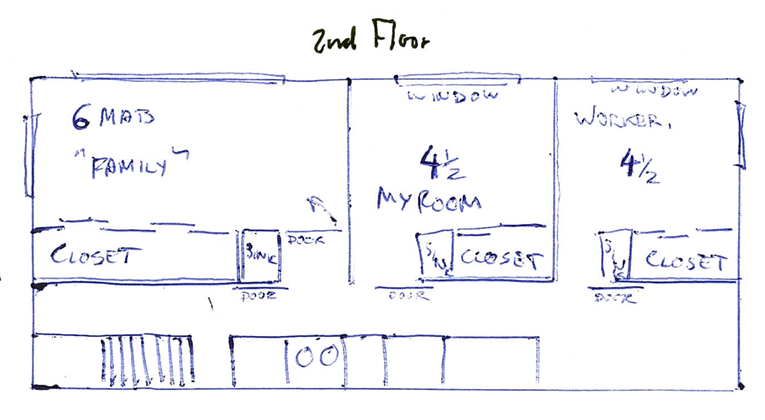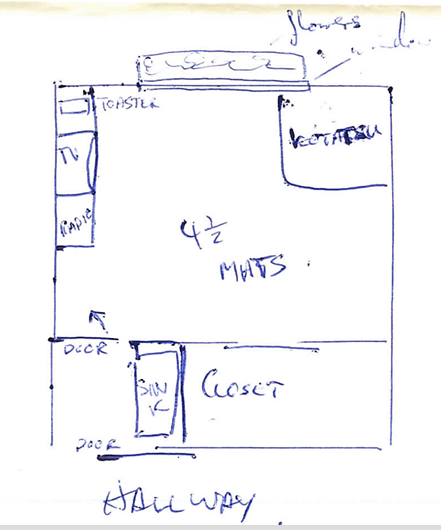Living in a Small Space
My College Paper
I n the fall of 1970, I went to International Christian University (国際基督教大学), in Tokyo, Japan, as part of a year abroad program from the University of California, Santa Barbara. I had lived in Japan before, but this time I went to study Intensive Japanese, and I wound up staying until the spring of 1972 to further my language skills. The first year, I lived in the First Men's Dorm (第一男子寮), a two story old wooden dormitory on campus. I had three other roommates, all Japanese, and the bunk beds and desks for all four of us were crammed into one small room. It was a very good experience, and involved occasional duties such as serving as receptionist for the dorm's single phone in a room next to the building entrance, and cleaning the toilets, among other things. For meals, we ate next door in the school cafeteria, where one of my favorite dishes in the morning was piping-hot sticky white rice, with a raw egg cracked over the top, and a garnish of dried seaweed and a dab of soy-sauce. I enjoyed communal living in my dorm, and I liked my roommates, but it was not always easy to sleep. One of my bunkmates was a member of a secrecy-prone, Communist political faction; late at night he and his pals would keep me awake by gathering right next to my bed to whisper their revolutionary theories (interestingly, his faction was regarded as truly wimpy by the real radicals in those heady days). Another somewhat idiosyncratic roommate always made a lot of noise late at night, walking across the room with his slapping slippers. He was later taken away, mumbling rather incoherently, after building a mini-funeral pyre for a dead cockroach on the wood floor of the room--an act which could have burned down the entire building.
In the middle of 1971, I moved off-campus into a yojôhan (四畳半), a four-and-a-half tatami mat room in an old apartment building nearby. It was a typical sort of lodging for impoverished students and members of the working-class in those days, the sort of dwelling space that is often depicted with humor, pathos, and nostalgia in novels, films, and even manga. Writer Kafû Nagai (永井荷風) depicts this space in his scandalously erotic 1917 novella, Yojôhan fusuma no shitabari (『四畳半襖の下張り』, or "The paper lining of the sliding door in a four-and-a-half mat room"). Manga artist Yoshihiro Tatsumi (辰巳ヨシヒロ)frequently depicts these sorts of lodgings in his manga, and Shinji Nagashima (永島慎二)wrote a manga story titled Yojôhan monogatari (四畳半の物語), or the " The Yojôhan Story." Manga artist, Leiji Matsumoto (松本零士) lovingly (?) featured them in his now-famous, Otoko Oidon (『男おいどん』or "I yam a Man!"), which ran in the weekly boy's Shûkan Shônen Magazine from May 9, 1971 to August 5, 1973. This work became part of a whole extended series of stories by Matsumoto, known as his "yojôhan series," all set in similar four-mat rooms and featuring a starvingrônin, (浪人; literally, a "masterless samurai," but in modern parlance a young person taking time off , working and trying to prepare to take the grueling exams required to get into college, often after flunking them once or twice).

As you can see from the paper I wrote, I lived on the second floor of a two-story apartment building. It was a rather flimsily constructed wood frame and gray stucco-walled structure. The steps of the shared staircase and the hallway floors were all wood and shiny, not only from being regularly swept by the building manager, but from everyone's socks or slippers having slid over them for years. The doors to each apartment room were sliding, and rattled when opened. They had flimsy and ridiculously primitive locks that barely worked, so that some people never even bothered to lock them. In those days, much of Tokyo still did not have a full sewage system, so the toilet, which was shared, was a squat-style kumitori benjo (汲み取り便所), which meant that everything that went into it fell two floors through a hole in the floor with a whoosh to land with a sploosh in a pit far below, and every so often a truck had to periodically come and suck out the contents in a noisy and smelly process, and take it away for fertilizer.

Inside my apartment room most of the floor was made of tatami grass mats, and at night I slept on them in a futon; in the day time the futon was stored in a small closet to make space to live on the tatami. Like most people in these apartments then, I had no phone, and had to walk to the nearest local public phone booth to make a call. Sometimes people even sent telegrams across town then, to contact others in an emergency. I also had no refrigerator, so I only bought enough to eat for a day or two, and in the summer had to be very careful that nothing spoiled. In a very tiny wood-floored area near the door I had a rudimentary gas burner to cook (there were bigger, common-use burners in the hallway), next to a small metal sink with cold running water. There was no hot water or bath in the building, and for baths I always went to the local sentô (銭湯)or public bath in the neighborhood. In those days, most students and working-class people did not have their own baths or showers, so bathing was communal in the local sentô, the men and women's bathing areas separated only by a wall that did not go all the way to the ceiling, thus allowing customers of both sexes to hear, if not see, each other chatting and gossiping while enjoying their soaks. On the walls above the large bathing tubs there were almost always ads hand-written in kanji, advertising neighborhood businesses, and a crude but lovingly rendered painting of Mt. Fuji in the distance, with a solitary pine tree poignantly perched on a hill in the foreground. Other than a kotatsu (炬燵;a table with blankets and a heat lamp to warm your legs), I did not have any heat, so in the winter going to the baths was a great way to get warm, but in near-freezing weather the walk to and from the bathhouse could be daunting.
The college paper on view here was written in March, 1972. I was studying Japanese intensively at the time, but my university also had a "Communications Department," with some classes in English that I took. Professor John C. Condon taught highly popular classes in intercultural communication. The late Dean Barnlund, visiting from San Francisco State University, taught a fascinating course on the influence of architecture on human communication, and it was for his course that I wrote this paper. Other than my Japanese language courses, I had little interest in my university courses, but this one was a real exception.
I was in my most romantic and impractical phase of life. I had just turned twenty-two and was about to graduate from being a naive college student to a truly naive hippy/neo-beatnik. I had grown up overseas and did not know America very well, but I dreamed of one day wandering barefoot around the country writing haiku. Like many people my age, I was powerfully influenced by American counterculture ideas, and by the writings of Kurt Vonnegut and Jack Kerouac, among others, but I was also in love with haiku poetry by Japanese poets. In this paper I felt very creative, and incorporated some of my own haiku, which Dr. Barnlund, to my surprise, seemed to like a great deal, for he gave me an A(!). The paper was handwritten because I had no typewriter and in those days frankly did not know how to type properly. In retrospect, I'm surprised that Dr. Barnlund could read my cramped and messy handwriting (I can hardly read it myself today).
Here's a short sample:
My room, with the closet and the genkan closed, is almost a perfect cube of sides less than 9 feet.
The bottom—
Snake-woven
Strands of soft-grown straw
Blend in a scent of low
Marsh fields.
The top, and the beams cutting across white plaster—
A natural Aura
Warm like life
Textures the room
With the kinship of wood.
There are four and one half tatami mats in this room, and when I lie down or stand up and stretch my arms, I can always touch the opposite side of the cube, whether it be the ceiling or the wall. Of course, with an over six foot height, I am a long match in a small box, but I have no real sense of being cramped, rather, a feeling of compactness and total security and efficiency. Everything can be reached with ease, and when it is so dark I cannot see, I can feel or sense without touching, the exact dimensions of my confines, and know that everything I own is in this area
Years later I lived in Tokyo in six-mat rooms, and even in what is called a nagaya, or long-house, with my own bath. I never did live in the concrete buildings that are so popular now in urban Japan. In the United States I lived briefly in a garage, and a doll house-like structure in a back yard, and in a barn. They were all interesting places, but I remember my yojôhan days with particular fondness. What my yojôhan lacked in physical comfort, it made up for with atmosphere, and closeness to nature. In fact, when I reflect back on it, it was almost like camping, but much more comfortable.
To read my full original paper, click HERE. Friends complained that my original handwriting is too hard to read, so I have typed up the paper and you can read it as a typed version HERE .

